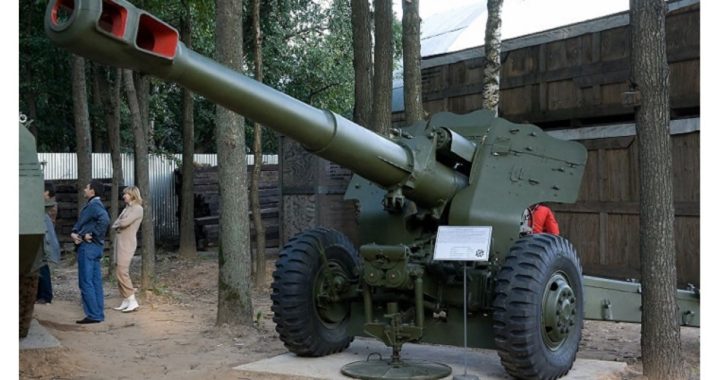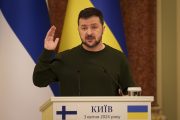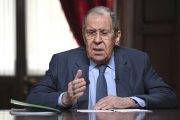
General Philip Breedlove, an American who is NATO’s supreme allied commander, Europe, as well as commander of U.S. European Command, has said that Russian troops and trucks carrying military equipment have crossed the border into the eastern part of Ukraine.
Breedlove said that NATO “is concerned about convoys of trucks taking artillery and supplies into east Ukraine from Russia.” The New York Times cited Breedlove’s statement that there are increased numbers of Russian forces in east Ukraine, presumably engaged in training militants.
The Times reported excerpts from Breedlove’s statement at a news conference in Sofia, Bulgaria:
Across the last two days we have seen the same thing that O.S.C.E. is reporting. We have seen columns of Russian equipment, primarily Russian tanks, Russian artillery, Russian air defense systems and Russian combat troops entering into Ukraine.
The OSCE, the Organization for Security and Co-operation in Europe, considers itself to be a regional organization in accordance with Chapter VIII of the UN Charter. The United States, Russia, and Ukraine are among its 57 members.
“We do not have a good picture at this time of how many [Russians have entered Ukraine],” Breedlove said. “We agree that there are multiple columns that we have seen; we agree with the OSCE reports. And as to their intent: I’m not sure.” The general added, “It is our first guess that these forces will go in to make this a more contiguous, more whole and capable pocket of land in order to then hold onto it long-term.”
Reuters reported this excerpt from Breedlove’s statement: “There is no question any more about Russia’s direct military involvement in Ukraine.”
Russia has denied that it has troops in Ukraine. Reuters quoted a Russian Defense Ministry official, General-Major Igor Konashenkov, who said in Moscow that “there were and are no facts” behind the statements and that Russia had stopped paying attention to such accusations by NATO.
However, a Reuters reporter saw unidentified military trucks in the center of Donetsk on Wednesday, with soldiers in green uniforms without insignia standing nearby. The reporter noted that Russian soldiers spotted by local residents have often had no insignia on their uniforms.
A November 12 report from VOA (Voice of America) News cited statements from NATO saying that its personnel have observed columns of Russian military equipment, including tanks, artillery, and combat troops, entering eastern Ukraine during the past two days.
VOA also reported General Breedlove’s statement that at least 250-300 Russian troops remain inside eastern Ukraine assisting the anti-government separatists. Breedlove also said that eight Russian battalions remain deployed on the Russian-Ukraine border, and that Moscow is moving forces capable of using nuclear weapons into Crimea, which it annexed from Ukraine in March.
Moscow has repeatedly denied any official military involvement in Ukraine, and has described Russian troops fighting alongside separatist fighters as volunteers.
VOA noted that OSCE monitors in eastern Ukraine reported on November 11 that they saw a convoy of unmarked green military trucks with tarpaulin covers just outside Donetsk moving toward the city center. The monitors said five of the trucks were each towing 120 millimeter Howitzer artillery pieces, while another five were each towing partly covered multi-launch rocket systems.
Ukraine, though not a NATO member, applied to join the NATO Membership Action plan in 2008. The nation’s plans to apply for membership in the alliance were postponed indefinitely after the 2010 election of Viktor Yanukovych as president, but since the start of the crisis with an insurgency by pro-Russian, anti-government rebels in 2014, support among the population for Ukrainian membership in NATO has risen greatly.
VOA also quoted Ukrainian military spokesman Andriy Lysenko as saying that what he described as “Russian mercenaries” are “strengthening and reinforcing” rebel forces near the “line of confrontation.”
The eastern and southern areas of Ukraine, near the Russian border, have been the site of unrest and conflict since the end of February 2014, when violent demonstrations by pro-Russian and anti-government groups occurred in major cities across those regions. Russian troops soon occupied the Crimean Peninsula, and a subsequent referendum and parliament vote resulted in the Crimean Parliament declaring independence from Ukraine and requesting to join the Russian Federation. Russia annexed Crimea in March.
Unrest has continued in the eastern areas of Ukraine, as Russian-supported rebels have been fighting Ukrainian forces since April. Separatists in the eastern regions of Donetsk and Luhansk declared independence after Russia annexed Crimea from Ukraine.
James Heiser wrote for The New American on September 4:
The level of Russian involvement in Ukraine is apparently now so extensive that Reuters is reporting that over 100 Russian soldiers have been killed in a single battle within Ukraine. According to Ella Polyakova (identified by Reuters as a member of “the Russian presidential human rights council”), the Russian soldiers were operating under contract; in Polyakova’s words, “When I talk to the guys who accompanied these coffins of these contract soldiers, they tell me that the order was given orally; there were no forms of documents.” “The soldiers serving on contract are given an order, and the columns go across Russia and they stop at a camp, as though part of a training exercise, on the border with Ukraine,” said Polyakova. “They take off all the (identification) numbers or blotch them out, and then cross the border,” she said.
On September 3, President Obama was in Tallinn, Estonia, one of the three Baltic states that were under Soviet occupation from the 1940s until the 1990s. We noted in our article that day that Russia’s intervention in Ukraine has unnerved some in the region, who fear that Russia may attempt to exert its influence among their Russian-speaking citizens. All three states — Estonia, Latvia, and Lithuania — are now NATO members.
During his speech in Estonia, Obama voiced harsh criticism of the Russian role in Ukraine. “It is a brazen assault on the territorial integrity of Ukraine, a sovereign and independent European nation,” he said. “It challenges that most basic of principles of our international system — that borders cannot be redrawn at the barrel of a gun; that nations have the right to determine their own future.”
Obama laid the blame squarely on Moscow for the continuation of the unrest there. “It was not the government in Kiev that destabilized eastern Ukraine; it’s been the pro-Russian separatists who are encouraged by Russia, financed by Russia, trained by Russia, supplied by Russia and armed by Russia,” said Obama. “These are the facts. They are provable. They are not subject to dispute.”
The president’s assessment of who was responsible for the crisis in Ukraine was fairly accurate. Nevertheless, that does not diminish the potential for NATO (meaning largely the United States) to be dragged into the conflict at some future point. While the conflict in Ukraine raged, Rapid Trident, a joint military exercise conducted annually for the past few years by the U.S. Army, NATO, and the Ukrainian military, went ahead from September 16-26.
As contributing writer Kenneth Raoza wrote in Forbes on September 3:
On Wednesday, just hours after Putin managed to convince pro-Russia separatists to cease fire, President Obama said in Estonia ahead of the upcoming NATO Summit that the U.S. and NATO would not allow a foreign country to encroach on its friends. He said this after blaming Moscow for the political turmoil in Ukraine. He was a hair away from saying that the U.S. would protect Ukraine from a Russian military attack.
Under NATO, the United States is expected to view an attack on any of the 27 other member nations — including Soviet-era Warsaw Pact nations that provided the rationale for creating NATO in 1949 — as an attack upon the United States. Article V of the North Atlantic Treaty makes this clear: “The Parties agree that an armed attack against one or more of them in Europe or North America shall be considered an attack against them all.”
Though Ukraine is not a NATO member — yet — the crisis there should serve as a warning of how the regional arrangement increases the odds of the United States being drawn into yet another overseas conflict.
Related articles:
Invasion of Ukraine Continues; Russian Ideologist Calls for “Genocide”
NATO Exercise in Ukraine Will Place U.S. Close to Conflict
Brits to Lead New NATO Division to Counter Russian Moves in Ukraine
President Obama Quietly Promotes a More Powerful NATO
Obama Unveils European Reassurance Initiative to Boost NATO



